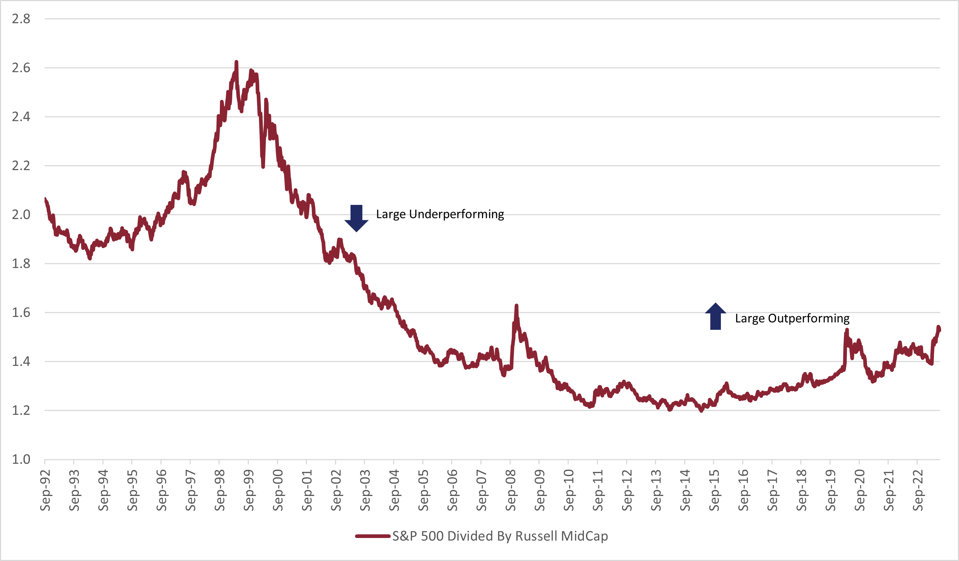As previously mentioned, the rise in stock prices has become more widespread, with small-cap stocks performing better after a mixed jobs report on June 2 allowed the Federal Reserve to avoid increasing short-term interest rates last week. Midcap stocks, which have been largely neglected in the past, are also experiencing a resurgence. Until the end of May, midcap stocks, as measured by the Russell MidCap index, had a slightly positive total return for the year so far, while the S&P 500 had increased nearly 10%. Since the beginning of June, the Russell MidCap has risen by over 6.7%, compared to the S&P 500’s 5.5%.

Midcap stocks fall within the middle range of market capitalization, positioned between highly-sized corporations and those with smaller market capitalization. As per the Russell Index guidelines, 200 of the most prominent market-capitalization enterprises belong to the mega-cap index, and the subsequent 800 belong to the Russell MidCap index. The Russell 1000 index combines the two aforementioned indexes, which people commonly know about. The Russell 2000 index comprises the next 2000 smaller companies.
Although midcap stocks have recently performed well, they have still fallen significantly behind the S&P 500 in terms of year-to-date results. However, it is not widely known that midcap stocks have actually outperformed small-cap stocks over the past five years, ten years, and even since 1994. In contrast to their underperformance against large-cap stocks in the previous five and ten years, mid-cap stocks have consistently surpassed them over the long haul.
As the saying goes, previous success does not ensure future accomplishments; therefore, what could cause midcap stocks to surpass their performance in the future? One potential explanation is that midcap corporations are often more excellent and dependable businesses in comparison to small-cap stocks. The Russell 2000 has more than 42% of its members not generating any profits. Normally, these midcap stocks have elevated from the small-cap section of the market, and at this point, the unsuccessful companies are typically discarded.
Analysts tend to focus on mega-cap companies, so they are typically more valued than small or obscure firms. Additionally, midcap companies are large enough to take advantage of economies of scale and diverse product offerings yet still have room for growth. Surprisingly, some well-known brands like Lululemon Athletica, Yum! Brands, and Clorox fall into the midcap category. Therefore, it could be argued that midcaps are the ideal investment opportunity.
Finally, the comparison between the value of midcap stocks and large-cap stocks suggests that midcap stocks are likely to perform better. According to estimates for 2023 earnings, midcap stocks are currently priced at 14.5 times their value, while the S&P 500 is priced at 19.9 times its value. This means that the difference in value is close to the highest it has been since the dot com bubble in the late-1990s. This period resulted in a significant outperformance of midcaps.
Last week, Federal Reserve Chair Powell stopped increasing rates like he wanted to. However, the Fed thinks that short-term interest rates should go up by 25 basis points (0.25%) twice in 2023. The market thinks the Fed will only increase short-term interest rates once at the July meeting. Even though the expected Fed funds rate could go up after the meeting, the bond market still thinks the Fed will cut rates within a year. This pause in rate hikes, along with the higher chance of avoiding a recession, could help midcap stocks continue to do well.
Over a prolonged period, midcap stocks have performed better than the S&P 500, and their current relative value indicates that investing in them is more advantageous. Although valuation is not a reliable measure of timing, it does suggest that midcap stocks have the potential to be a good long-term investment. While the market’s overall performance broadens, recent developments have indicated that midcap stocks may continue to perform well. Investors should take an active approach when investing in this area or, alternatively, purchase the iShares Russell Mid-Cap ETF (IWR) which is both tax-efficient and low-cost.



